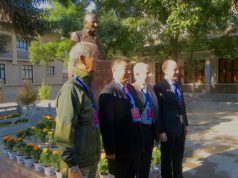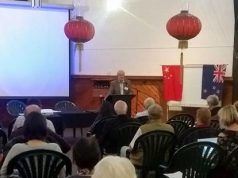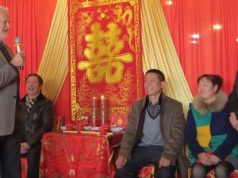NZCFS 1952 – 2012 Sixty Years
Season’s Greetings
As we come to the end of a very historical and busy year, I would like to wish you all the very best for the coming Christmas festive season. Historical because we celebrated our first Sixty Years since our formation in Auckland in February 1952 with a number of very important celebrations and events. But historical also because those celebrations saw the creation of two very important funds that will be vital catalysts for our activities for the next few years ahead.
These two funds are:
The Rewi Alley Friendship and Exchange Fund of one million RMB ($200,000) granted over five years and created by the People’s Association for Friendship with Foreign Countries (Youxie) through the China Oceania Friendship Association and the China Friendship Foundation for Peace and Development.
The Simon Deng Li Arts & Culture Fund of one million RMB over the same period of five years is the very generous donation of Simon Deng Li, Managing Director of Rainbow China Culture and Media Group (NZ) Ltd of Auckland, and initiated through George Andrews, Auckland Branch President.
The first grants have been received and our first projects are either underway or are being called for. We will be able to give you more details in due course on these and recommend that branches look seriously at projects that will meet the criteria for each that your local committee would like to focus on. More details in the new year.
We are pleased to advise that Simon Deng Li has accepted an appointment as Honorary Patron of our Society in recognition of the work he has already done in promoting Chinese arts and culture in New Zealand and for what he is supporting through the creation of the Simon Deng Li Arts and Culture Fund. Thank you very much Simon, we look forward to working with you and your enthusiasm for the exchange of arts and culture between China and New Zealand.
Recent times have been particularly busy for me as your National President and I was honoured to lead the Prominent Persons’ Delegation in September to the Regional Forum in Changchun, Jilin and the Friendship Cities’ Conference in Chengdu, Sichuan. At the first I presented a paper on New Zealand-China Trade in the future and signed a Friendship Memorandum of Understanding on developing Friendship with the host Province Jilin.
Eric Livingstone National President
Rewi Alley Friendship & Exchange Fund (RAFE)
These projects have been selected:
- Training Young People in Cooperatives at Shandan Bailie School Cooperative Training Centre in Gansu, China. The project will provide practical training for 20 young people aged 18 to 25 from rural cooperatives, enabling them to contribute to the development of their cooperatives and communities. Young people often leave the rural area to work in eastern cities and this training offers them a reason to stay and work at home.
- Michael King Writer’s Residency in Auckland—A Chinese writer will be selected as the inaugural ‘Rewi Alley writer in residence’ at the Michael King Writers’ Centre for eight weeks.
- New Zealand-China Youth Exchange—A new Internship worth $5000 has been set up for a young New Zealander who wishes to engage with Chinese people and society. This opens up possibilities for anyone interested in establishing greater cultural relations with China, or helping to assist communities within China, or indeed, any other specific cultural learning proposal. In fact, the possibilities are endless. The application form is on our website https://nzchinasociety.org.nz/11545/
- Rewi Alley papers – Professor Dov Bing, in the Department of Political Science & Public Policy, Faculty of Arts and Social Sciences, University of Waikato, has papers written in 1973 on Rewi Alley by Professor James Bertram, H. Courtney Archer, Lewish Smythe, Ida Pruit, Professor Ralph Lapwood, Helen Foster Snow, Professor Brian Harland, Barbara Spencer, Professor Joseph Needham and himself. The RAFE fund will provide for the typing of these papers for publication.
Onions, musk and kiwifruit:
Our Society’s heartening relationship with China’s rural co-operatives
Miles Barker, Hamilton Branch
Learning about how China’s rural co-operatives function was, for me, one of the most meaningful, inspiring and future-focussed outcomes from the New Zealand China Friendship Society’s recent ‘Birthday Tour’. This was perhaps unexpected, given that – as its title suggests – the tour’s major emphasis was elsewhere: the year 2012 marked the 40th anniversary of New Zealand/People’s Republic of China diplomatic relations (1972), the 60th anniversary of the founding of the first branch of the New Zealand Society (1952), the seventieth anniversary of the Shandan Bailie School (1942), and the 125th anniversary of the birth of Rewi Alley (1897). All four of these anniversaries were indeed celebrated in joyful and emphatic style by the fifteen of us who journeyed by plane, train and bus across northern China from Kashgar, in China’s north-western Xinjiang province, to Beijing over the period from 29th August to 24th September 2012.
Our visits to three rural co-operatives turned out to be a delightful and significant feature of the tour. While some of us slept during long hauls on the bus, tour leader Dave Bromwich was frequently phoning ahead, reconnecting personally with co-operatives’ leaders, and establishing whether a visit by us at short notice would be timely, convenient and welcome.
The need for co-operatives in China was obvious early in our tour: lone roadside watermelon sellers, unable to entice a few buyers, compete with each other and probably return home at dusk with up to one third of their wares spoiled by sun, dust, pollution and insects. Co-operatives, by contrast, are a unique form of organisation where individual members collectively own, and democratically manage, an enterprise for the mutual benefit of all members.
Over the years, the Chinese government has supported the formation of various forms of collective organisations including communes with the aim of improving economic development and reducing poverty in rural areas. However since the introduction of the Specialized Farmers’ Cooperative Law in 2007, there has been a spectacular upsurge in the formation and registration of rural agricultural cooperatives all over China. No doubt, many of our Society members perceive resonances in the re-emergence of the co-operatives with the work of Rewi Alley and the Maori notion of ‘mahi tahi’.
The first of our three visits to co-operatives occurred on a peaceful autumn afternoon, just outside Shandan city, Gansu province, where we 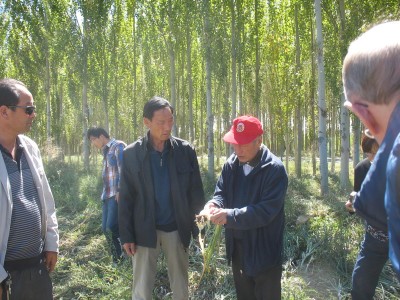 gathered in the corner of a huge field of onions lying ready for collection. As we talked with two representatives of the co-operative, workers in the distance bagged the crop and piled trucks high with bulging sacks. Later, back in town, we crowded into the co-operative’s upstairs office. The discussion in the field had been intensely practical (varieties of onions, soil types and preparation, pesticides, storage, markets); now the focus was on administration, governance, funding, distribution of profits, and issues of equity.
gathered in the corner of a huge field of onions lying ready for collection. As we talked with two representatives of the co-operative, workers in the distance bagged the crop and piled trucks high with bulging sacks. Later, back in town, we crowded into the co-operative’s upstairs office. The discussion in the field had been intensely practical (varieties of onions, soil types and preparation, pesticides, storage, markets); now the focus was on administration, governance, funding, distribution of profits, and issues of equity.
The second visit occurred a few days later in the town of Fengxian, in hilly, southern Shaanxi province, where we visited a musk co-operative. On a chilly, misty afternoon, but cosy in a gracious villa, we learned how traditional local knowledge about the indigenous deer populations was fusing with the science of genetics and animal husbandry to produce a thriving industry. And later we peeked at the deer themselves – delicate, gracious, skittish animals.
The next afternoon, travelling across the broad dusty country that leads to Shaanxi’s capital, Xian, we made our third visit – to a kiwifruit co-operative at 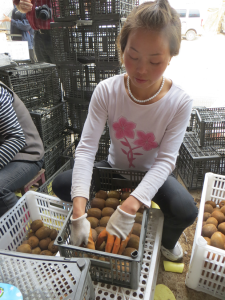 Meixian. As our bus turned into the walled courtyard, many of us felt we were in recognizable territory: the piles of crates, the huge sealed doors leading to the cool stores, and the posters publicising the familiar leafy vines with clusters of brown luscious fruit. We were soon free to wander around and talk to the busy workers: lorry drivers, administrators, and the chain of women sorting and grading piles of fruit into the crates. Acquiring a packing shed was this co-operative’s next priority.
Meixian. As our bus turned into the walled courtyard, many of us felt we were in recognizable territory: the piles of crates, the huge sealed doors leading to the cool stores, and the posters publicising the familiar leafy vines with clusters of brown luscious fruit. We were soon free to wander around and talk to the busy workers: lorry drivers, administrators, and the chain of women sorting and grading piles of fruit into the crates. Acquiring a packing shed was this co-operative’s next priority.
By way of overview, I do not intend to elaborate here on the quantitative and statistical side of these three co-operatives, or of Chinese co-operatives at large. I would, however, like to point out that our Society is far from being a spectator in the development of Chinese co-operatives. As modern cooperatives are set up right across China, NZCFS has significant involvement in the spreading of emerging expertise in an expanding area of North-west China. Through a programme of cooperative development projects, Dave Bromwich and NZCFS has worked with Shandan Bailie School to provide financial support to train cooperative members and leaders in broad aspects of cooperative establishment and management. On this tour, as part of the United Nations International Year of the Cooperative, NZCFS and counterparts presented ‘Outstanding Cooperative’ awards to six of our project cooperatives.
All of this caused me to ponder further the slogan for our national conference in Auckland in May of this year: “In honouring our past, we find our future”. As one who has a great love of, and respect for, history, (I have published works on New Zealand history, the history of science, and historiography) I cherish the lines of philosophical connection between the work of those brave and enlightened New Zealanders in the first half of the twentieth century and contemporary China. But connections become indirect, people age, and memories grow dim. In contrast, what I saw of our work with the co-operatives suggests that here is a clear additional pathway to finding our future. Everywhere we were received not just with warmth and enthusiasm but with the feeling of being ongoing colleagues and partners. The three leaders (one man, two women) all expressed a positive vigour and enthusiasm, tinged with modesty and dignity. One of my most treasured images of the ‘Birthday Tour’ will undoubtedly be of the packers at the kiwifruit co-operative as they charged down the ramp to join us in the courtyard for a hilarious group photo. Their vibrancy, their so evident friendship towards us, and their optimism about their own and China’s future, couldn’t have been clearer.
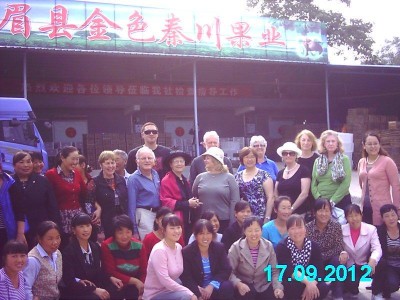
Awards to mark the 60th Anniversary of NZCFS
and 2012 UN Year of the Cooperative
Since 2006, our projects in north west China to establish model cooperatives have provided direct benefits to almost 10,000 households, with one now expanded to 1196 household members. Currently NZCFS projects have directly established 41 cooperatives in Zhangye/Shandan, Gansu, and 8 in Shaanxi. NZCFS recognized the 2012 UN Year of the Cooperative by making six awards to cooperatives selected from our projects to “Outstanding Cooperatives” who received a plaque plus 2500 RMB (approx. $500), which were presented at two formal ceremonies.
Two key factors in the selection for this award were: excellent management providing very good returns to cooperative members in areas of income, market security and collaboration, and members awareness of cooperative functions, transparent management systems and encouragement of their participation, all essential factors to sustain a strong cooperative.
The cooperatives selected were, in Shandan:
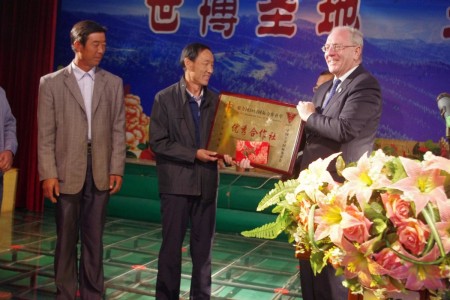
Ludadi Green vegetable cooperative
Ronghua specialist planting cooperative
Xinxiang animal breeding cooperative.
In Shaanxi:
Meixian Kiwifruit producer cooperative
Qianyang Xinxing crafts cooperative
Yangxian County Seedlings Production cooperative
EXPLORE CHINA TOUR: The South-East
April 6 – 26 , 2013
This tour starts in Guangzhou, visiting Fujian and Jiangsu Provinces and leaving from Shanghai. This region is fascinating with many highlights.
Fujian is on the coast and Quanzhou was the port where the great Ming Dynasty fleet under Zhang He sailed from. The city was once the eastern terminus of the Maritime Silk Road and home to a large (100,000 by some estimates!) international community, mostly Arabs but also including Persians, Indians and others. The English word “satin” comes from “Zaiton”, the Arabic name for Quanzhou, the port from which that fabric first reached the West. Marco Polo sailed home from Quanzhou and described it as the world’s busiest port.
Fully escorted, 3 – star twin share accommodation.
All inclusive price $6950 (estimated, subject to currency exchange), includes domestic flights in NZ, all meals, etc (excludes Chinese visa and insurances).
See the tours page for more information.



